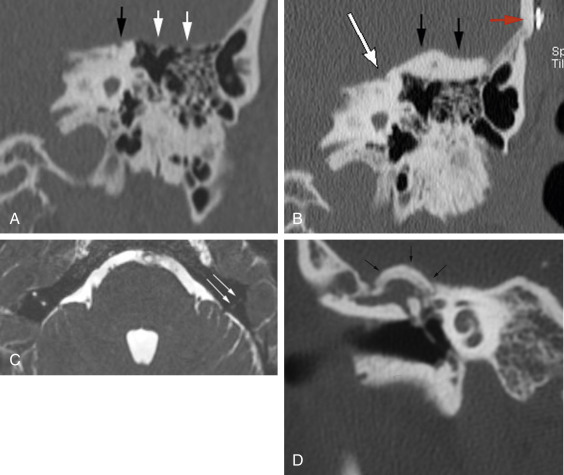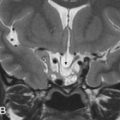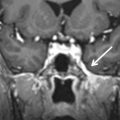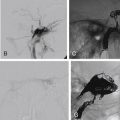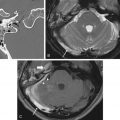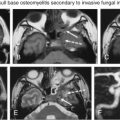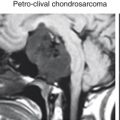Abstract
Interpretation of CT or MR imaging examinations performed on patients with a history of middle ear, mastoid, or neurotologic surgery can be challenging. This is greatly simplified by knowing the surgical procedures used. Knowledge of the expected normal versus abnormal postoperative appearance is the key to recognizing complications or recurrent disease.
This chapter initially discusses the surgical approaches to the middle ear and mastoid (transcanal, retroauricular, endaural) and the procedures facilitated by these (meatoplasty, canaloplasty, myringoplasty, tympanoplasty, ossiculoplasty, stapedectomy, mastoidectomy). Imaging findings indicative of recurrent disease are then discussed to include MR imaging for the detection of cholesteatoma.
The chapter concludes with a discussion of surgical approaches to the internal auditory canal and otic capsule (retrosigmoid, middle cranial fossa, translabyrinthine, transmastoid) for the management of tumors and superior semicircular canal dehiscence.
Keywords
Canaloplasty, Cholesteatoma, Mastoidectomy, Meatoplasty, Ossiculoplasty, Retrosigmoid, Translabyrinthine, Tympanoplasty, Vestibular schwannoma
Introduction
Interpretation of CT or MR imaging examinations performed on patients with a history of middle ear (ME), mastoid, or neurotologic surgery can be challenging. This is greatly simplified by knowing the surgical procedures used and the expected postoperative appearance. Knowledge of the normal postoperative appearance and the current clinical situation is the key to recognizing recurrent disease.
The goal of surgery in the ME, mastoid, and posterior fossa is the elimination of disease and, if possible, the preservation or restoration of normal function. The approaches and procedures discussed may be performed singularly or in combination.
Transcanal Approach
Surgery is performed through the external auditory canal (EAC) with the aid of a microscope and ear speculum. Visualization of the tympanic membrane (TM) is limited anteriorly and posteriorly without drilling of bone. Drilling may occur anywhere in the bony canal depending on the need for exposure or for removal of disease.
Drilling is the preferred approach for EAC stenosis, exostosis, EAC osteomas, myringitis, repair of central perforations, placement of pressure equalization tubes, and so forth. There may be little evidence of postoperative change in the EAC. Typical CT findings include thinning, irregularity or flattening of bone, soft tissue thickening, and bone wall defects. A larger appearing bony EAC may be evident from drilling of bone posteriorly lateral to or at the level of the isthmus ( Fig. 10.1 ). Advantages include limited surgical dissection, so postoperative pain is diminished. As a result, patients normally return to their presurgical functional status within 1–2 days.

Retroauricular and Endaural Approaches
For the endaural approach, an incision is made between the tragus and helix. For the retroauricular approach, an incision is made posterior to the ear with the ear reflected anteriorly. Both provide excellent exposure to the EAC and facilitate tympanoplasty when the transcanal approach cannot give the necessary visualization. These are the primary approaches for many otologic mastoid procedures. The approach chosen depends on the surgical goals and training of the surgeon; the retroauricular approach is more commonly used in the United States. Both approaches require the use of a dressing that can be removed the next day. The postoperative recovery period is 4–5 days longer than that of the transcanal approach.
Meatoplasty and Canaloplasty
Meatoplasty involves surgery of the external auditory meatus, whereas canaloplasty is performed more medially primarily in the osseous portion of the EAC. Both involve removal of disease while restoring patency of the meatus/canal.
Myringoplasty
Myringoplasty, also known as “type 1 tympanoplasty,” refers to surgery performed on the eardrum. The aim of myringoplasty is to restore the normal functions of the TM. The procedure may be simple, such as patching small perforations, or more complex, including lasering of chronic myringitis, removal of myringosclerotic plaques, or, in the case of larger perforations, reconstructing the entire TM with a variety of grafts (temporal fascia, tragus perichondrium, etc.). The TM postoperatively can be quite variable in appearance on CT, appearing so thin as to be barely perceptible or thickened focally/diffusely. Blunting of the anterior angle of the EAC is common; this “acute” angle is formed by the TM and the adjacent anterior wall of the EAC.
Tympanoplasty
Although tympanoplasty and myringoplasty seem to be synonymous, the term “tympanoplasty” may include surgery involving the TM, ossicles, and associated ME disease.
A tympanoplasty classification developed by Wullstein in 1956 included five types.
Type 1—Tympanoplasty with intact ossicular chain.
Type 2—Malleus partially eroded.
Type 3—Malleus and incus eroded, TM/graft extends to the intact stapes.
Type 4—Stapes superstructure eroded but footplate is mobile.
Type 5—Reconstruction with a fixed stapes footplate, a graft extending to a horizontal semicircular canal fenestration.
With the advancement of surgical techniques/instruments and development of ossicular prosthesis, the classification has been modified over the years. For example, the Type 5 tympanoplasty is now of historical interest only ( Fig. 10.2 ).
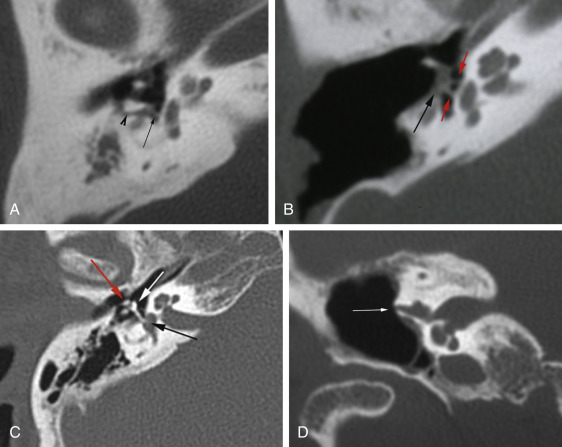
Although Wullstein’s classification describes the anatomic situation, there have been attempts to modify it with regards to prognosis and functional results. In 1971, Austin included the status of the ossicular chain as a prognostic factor for hearing results. In 1973, Belluci proposed a dual classification, also taking into consideration the presence or absence of ME disease; the spectrum extended from Group 1, a disease-free dry ear, through Group 4, a draining ear with nasopharyngeal malformation (cleft palate, choanal atresia). In 1994, Kartush described the Middle Ear Risk Index, which combines the Belluci and Austin schemes with additional prognostic factors, including the status of the TM, presence/absence of cholesteatoma, ME effusion/granulation tissue, history of prior surgery, and smoking status.
Ossiculoplasty
Ossiculoplasty reconstructs a sound-conducting mechanism between the TM/graft and oval window. The surgery performed is dependent on the ossicular deficit. Variations include the use of a prosthesis, autologous ossicle (most commonly the incus), bone cement, cartilage, etc.
In general terms, a partial ossicular replacement prosthesis extends from the TM, malleus, or incus to an intact stapes with mobile footplate. A total ossicular replacement prosthesis (TORP) extends to the footplate, a term used even if other ossicles and the stapes superstructure are present. A stapes prosthesis is a form of TORP but is often referred to as a “stapes prosthesis.” Because of the wide variety of ossicular and prosthesis combinations, it is best to describe the actual anatomic situation ( Fig. 10.2 ).
The prosthesis and materials used are numerous and are in general made from calcified particles or hydroxyapatite, metal (e.g., titanium), or plastic (e.g., plastipore). Stacked cartilage and bone cement may also be used with or without a prosthesis. Specific prostheses are not discussed here because they are numerous and in constant evolution. It is helpful to become familiar with the techniques and prosthesis used locally by your surgeons.
There are two important points regarding ossiculoplasty. First, look for continuity of the ossicular chain-prosthesis from the TM/graft to the stapes or footplate ( Fig. 10.3 ). Off-axis reformatted images are often valuable for this purpose. The ossicular reconstructions used are quite variable and not always a “straight line” or centered on the footplate ( Fig. 10.2C ). The prosthesis may extend just deep to the footplate but should not extend into the medial half of the vestibule ( Fig. 10.3C ). It is important to remember that the apparent penetration below the footplate estimated by CT may be more or less than the actual penetration anatomically, particularly in the case of a metallic prosthesis with streak artifact. Second, audiometry trumps imaging. That is to say, if there is significant conductive hearing loss (CHL), even with a “satisfactory” imaging appearance, the patient will need revision surgery.

Imaging After Stapedectomy
Stapes surgery is performed most commonly for otosclerosis with an intact ossicular chain but with stapes footplate fixation. The role of preoperative imaging is to confirm the diagnosis and exclude a third window that may be the actual cause of hearing loss. The extent of stapes resection is variable, and the footplate may remain in place. A stapedotomy is a small hole drilled and/or lasered in the footplate to facilitate placement of a prosthesis through the footplate. Surgery is considered successful if the air-bone gap is closed to 10 dB or less. In a large series with mobile malleus and incus, this was achieved in 94.2% of patients.
In the typical case of otosclerosis, the malleus and incus remain, with a prosthesis attached to the long process of the incus extending medially through a stapedotomy. Penetration into the vestibule is variable, typically less than 50% of the width of the vestibule. Pneumolabyrinth is common in the first week after surgery. Beyond a week, a perilymphatic fistula should be suspected.
In broad terms, over time patients may require revision surgery for recurrent CHL, sensorineural hearing loss (SNHL), vestibular symptoms, or mixed hearing loss. High-resolution CT may be useful in defining the etiology and for surgical planning purposes. In a study of patients undergoing revision stapes surgery, the authors were able to prospectively identify all cases of oval window dislocation, incus erosion with lateralized prosthesis, and short piston. Most but not all cases of obliterative otosclerosis were identified. CT was less accurate in cases of long pistons. Surgical findings in patients undergoing revision surgery without CT findings included a nonmobile piston encased in scar or new bone formation and prosthesis uncrimping.
CHL after stapes surgery most frequently occurs on a delayed basis. In 80% of cases this results from prosthesis migration or dislocation. Lagleyre et al. in reporting their series of 119 revision surgeries for CHL described a “lateralized piston syndrome” in 18.5% of those revisions. Preoperative CT demonstrated a lateralized piston in 81% of cases touching the TM. In 54.5% there was closure of the stapedotomy with incus necrosis in 77%. In a separate study of 201 revision stapes surgeries, prosthesis lateralization occurred in 53%, incus necrosis in 33%, reossification of the footplate in 31%, and uncrimping of the prosthesis to the incus in 9%. Ossicular necrosis after stapes surgery most commonly involves the long process of the incus at the point of prosthesis attachment. There are rare reports of ossicular necrosis unrelated to ME disease or surgery.
Vestibular symptoms and/or progressive SNHL occur in 0.6%–3% of patients after initial surgery and up to 14% of patients after revision surgery. Etiologies include serous or infectious labyrinthitis, reparative granuloma, labyrinthine fistula, or intravestibular foreign body. Progressive otosclerosis may lead to CHL or SNHL and may be seen many years after the initial surgery. In a Swedish study evaluating patients 30 years after stapedectomy, patients demonstrated primarily progression of SNHL, which could not be explained by age alone.
Mastoidectomy
The term “mastoidectomy” is a general term referring to removal of a segment of the mastoid cortex and subjacent air cells to deal with disease, for access to the ME, inner ear (e.g., cochlear implantation), or endolymphatic sac (for shunting), or for the repair of superior canal dehiscence, etc. Anterior and superiorly, the surgery may extend to the epitympanum and the anterior attic region, with the geniculate ganglion the anteriormost landmark. The size of the mastoidectomy defect is quite variable and depends on the degree of mastoid pneumatization, extent of disease, and procedures performed. The smallest defects are in patients with no mastoid disease, and the surgery is performed for the placement of an endolymphatic shunt ( Fig. 10.4B ). Large defects are seen in patients with well-pneumatized mastoids with extensive disease, and they require complete air cell exenteration. Rarely, patients may present after automastoidectomy; the CT appearance mimics a mastoid surgical defect ( Fig. 10.4A ).

Preoperatively, radiologists should make note of very sclerotic mastoids, especially those with almost no aeration of the mastoid antrum and a low-lying tegmen. In these patients, the transmastoid approach can be dangerous because it is difficult to delineate the lateral semicircular canal and second genu of the facial nerve, both of which may be injured at the time of surgery. On postoperative scans in these patients it is common to see thinning of bone or small surgical defects in the mastoid tegmen, mastoid segment of cranial nerve (CN) 7, or sinodural plate.
The posterior wall of the EAC may be left intact or resected. When intact, this is commonly referred to as a “closed” mastoidectomy or mastoidectomy with intact posterior canal wall ( Fig. 10.4C ). If the posterior canal wall is removed, this is referred to as mastoidectomy with takedown of the posterior canal wall or “open” mastoidectomy ( Fig. 10.5A ). The posterior canal wall may be removed, allowing wider access to the ME and mastoid, and then replaced or reconstructed immediately or at a later date ( Fig. 10.5B ). Materials used include the original canal wall, autologous bone, bone substitutes, or a prosthesis. This reconstruction may be combined with mastoid “obliteration” to reduce the size of the mastoid defect for quality-of-life issues to include elimination of maloderous drainage, caloric-effect vertigo, and lifelong water precautions and for improved cosmesis, ease of care, and facilitating placement of a hearing aid ( Fig. 10.5C ).
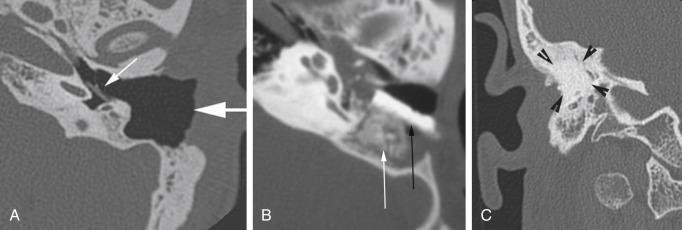
In the case of cholesteatoma, with the canal wall down mastoidectomy and meatoplasty, additional surgery is required in approximately 10% of patients. With the intact canal wall mastoidectomy for cholesteatoma, historically a “second-look” surgery was often required, as residual/recurrent cholesteatoma was seen in a significant number of patients, even if the surgeon believes all cholesteatoma was removed grossly during the initial operation. A common site for recurrent cholesteatoma is around the oval window because complete surgical removal of the cholesteatoma around the facial nerve or that adherent to the mobile stapes footplate can result in facial nerve paralysis or SNHL, tinnitus, or dizziness with vertigo.
Facial Recess Approach
This approach is performed with an intact canal wall mastoidectomy with an opening made just medial to the chordal eminence and lateral to the mastoid segment of the facial nerve. This approach is used for cochlear implant surgery and as a means for removal of disease in the facial recess and ME ( Fig. 10.4C ).
Atticotomy
An atticotomy refers to removal of the lateral wall of the epitympanum. This is not typically described separately for a patient after mastoidectomy, as the lateral wall may be removed as part of the mastoid procedure. On occasion, however, atticotomy alone is performed with variable absence of the scutum and lateral attic wall. The mastoid cortex and posterior canal wall appear normal. An isolated atticotomy is best visualized on coronal images.
Imaging the Postoperative Mastoid
Patients are not typically imaged immediately unless complications are suspected. Immediately after surgery, it is normal to see soft tissue swelling, absorbable gelatin sponge, mastoid cell opacification, and fluid levels. For intracranial complications, such as stroke, dural sinus thrombosis, abscess, or cerebritis, MR of the brain, MRA, and MRV are preferred. CT has a limited role but may be useful if there is clinical concern for cerebrospinal fluid (CSF) leak, facial nerve injury, or labyrinthine fistula.
In the more typical case, patients are imaged months or years after surgery for progressive hearing loss, drainage, or cholesteatoma. Postoperative CT imaging after mastoidectomy for inflammatory disease or cholesteatoma is challenging with regard to differentiating acute disease from chronic, nonactive disease or intentional mastoid obliteration. Mild flat smooth soft tissue thickening with otherwise good aeration is commonly seen and represents scar or granulation tissue. More extensive thickening, especially when accompanied by fluid or complete opacification of the ME and mastoid, is more likely to represent active disease. It is common to see soft tissue opacification of residual mastoid air cells and around the margins of the mastoid defect, especially if the margins are irregular with “overhanging” edges. Patients with Eustachian tube dysfunction often have retained fluid.
Hazy ill-defined new bone formation is occasionally seen about the margins of the mastoid and ME. When seen, this should suggest active inflammation ( Fig. 10.6A and B ).

Tympanosclerosis (myringosclerosis if confined to the TM) refers to fibrous tissue, calcification, or new bone formation in response to chronic otitis media ( Fig. 10.6D ).
It is important to note the presence and extent of tympanosclerosis. It is a cause of CHL poorly visualized by the surgeon. Tympanosclerotic fixation of the malleus and incus most commonly occurs in the lateral epitympanum or involves the stapes footplate. The scarring obliterates normal ME landmarks that the surgeon relies on for orientation. This increases morbidity and results in longer operative times.
Recurrent cholesteatoma may be difficult to diagnose with certainty by CT, especially when it is surrounded by inflammatory disease or fluid. Cholesteatoma may recur in the EAC, TM, ME, or mastoid. Progressive bone erosion should always raise concern, but this requires a baseline postoperative examination (rarely indicated) to be differentiated from preoperative erosion or operative drilling. A focal round soft tissue mass is suspicious but nonspecific and indicates differential considerations other than cholesteatoma, including encephalocele-meningocele and cholesterol granuloma ( Fig. 10.6C and E ). It is important to inspect the tegmen to be sure it is intact. On occasion, a mass will have irregular air-filled interstices from shedding of keratin debris ( Fig. 10.6C ). Rarely, the cholesteatoma contents are shed or removed, with only the peripheral matrix remaining, a so-called thin-walled or mural cholesteatoma. These cholesteatomas are very slow growing and may not be detectible by CT or MR.
MR Diffusion Imaging for Cholesteatoma
The incidence of residual/recurrent cholesteatoma has been reported to be 9%–70% after intact canal wall surgery versus 4%–17% for canal wall down mastoidectomy. For this reason, the historical standard of care has been a second-look surgery, particularly with an intact canal wall. Historically, MR was infrequently performed because it seldom altered traditional surgical management.
Numerous articles over the past 10+ years have explored the use of MR diffusion-weighted imaging (DWI), initially echo planar (EP), subsequently non-echo planar (NEP), for the detection of cholesteatoma. Using the NEP-DWI, cholesteatomas as small as 2 mm have been reported. In the context of the postoperative patient, this has resulted in a potential paradigm shift emphasizing MR over CT or second-look surgery for the detection of residual/recurrent cholesteatoma.
On MR imaging, a cholesteatoma demonstrates T1 hypointense and T2 hyperintense signal. Post-Gd, there is usually a rim of enhancing tissue around the nonenhancing cholesteatoma ( Fig. 10.7 ). Early reports described the benefit of delayed imaging after contrast administration; more recent reports suggest gadolinium is unnecessary unless otherwise indicated.

False positives in early reports included skull base artifact with EP-DWI; this is less of an issue with NEP-DWI. Other false positives have been from cartilage or bone dust (used in reconstruction), wax/cerumen, and mastoid abscess (usually evident clinically). False negatives have occurred from tiny (less than 2 mm) or “mural” (thin-walled) cholesteatomas. Improper technique and patient motion may also result in false negatives.
In one series, 31% of patients with a negative initial postoperative NEP-DWI study subsequently demonstrated DWI evidence for cholesteatoma. In another study, 12 patients were followed up clinically without surgery, 7 of whom showed regression in size or absence of a persistent DWI finding on follow-up imaging. The appropriate scanning interval and number of scans following surgery remains to be determined. Although these reports suggest imaging may be sufficient to exclude significant residual/recurrent disease, it will take time for otologists in general to abandon the concept of second-look surgery.
Superior Canal Dehiscence—Postoperative Imaging
Superior semicircular canal dehiscence (SSCD) syndrome was first reported by Dr. Minor in 1998. The most common location for labyrinthine dehiscence (third window) is the arcuate eminence of the superior semicircular canal (SSC). Less common locations include between a superior petrosal sinus and the SSC, the posterior semicircular canal (spontaneous or from jugular vein enlargement/diverticulum), cochlear carotid interval, between the facial nerve and basal turn of the cochlea, or from a subarcuate vessel with the third window the undersurface of the SSC. There have been reports of a similar third window phenomenon with lesions of the temporal bone, including meningioma, fibrous dysplasia, cavitary otosclerosis, and Paget disease.
There is evidence that SSCD is part of a more general process of acquired skull base thinning that includes the temporal bone tegmen and geniculate ganglion, and the incidence increases with age. An association with obesity and obstructive sleep apnea has been described, with or without CSF leak.
Patients with SSCD are offered surgery if they fulfill three criteria. First, classic symptoms (pressure or sound-induced vertigo, oscillopsia, hyperacusis, autophony, aural fullness, hearing loss, and tinnitus). Second, evidence of a third window with absence of other findings that might explain the presenting symptoms such as otosclerosis. Third, testing results that support the diagnosis (audiometry, vestibular symptoms, vestibular evoked myogenic potential (ocular and cervical, oVEMP and cVEMP respectively) air-bone gap). Because the spectrum of defects ranges from “near dehiscence” to “wide dehiscence,” there is some basis to suggest that symptoms and test results will vary as well. The final decision to perform surgery is the judgment of an experienced surgeon.
Surgery is performed via a middle cranial fossa or transmastoid approach. The transmastoid approach has the advantage of avoiding a craniotomy with temporal lobe elevation but may be precluded by a low-lying tegmen. The surgical goal is to plug the superior canal on either side of the dehiscence with or without resurfacing of the defect. In theory, both the plugging material and dehiscence covering should protect the remaining inner ear structures from CSF pulsations. This would favor “hard” (bone dust/chips/grafts, bone cement) over “soft” (fascia, bone wax) plugging and covering materials. An analysis of reported outcomes suggested the transmastoid approach has a lower complication and revision rate, with a shorter hospital stay.
Imaging is typically reserved for persistent or recurrent symptoms. The postoperative imaging results may be quite variable depending on the site of the third window and the material used for plugging/resurfacing. In a report on revision surgery for failed initial surgery, the authors noted a variety of materials used for resurfacing, including fascia, bone chips, bone dust, bone wax, fibrin glue, injectable hydroxyapatite, a stapes piston, and bone grafts. In that series, 80% of patients had undergone both resurfacing of the dehiscence and plugging of the superior canal on both sides of the dehiscence. In patients undergoing surgery for SSCD, it is common to see postsurgical changes involving a tegmen repair as well. Repair of a tegmen defect with little apparent surgical change by CT imaging at the site of SSCD should not be mistaken for “wrong site” surgery or lateral migration of a “hard” cover ( Fig. 10.8A,B, and D ).

